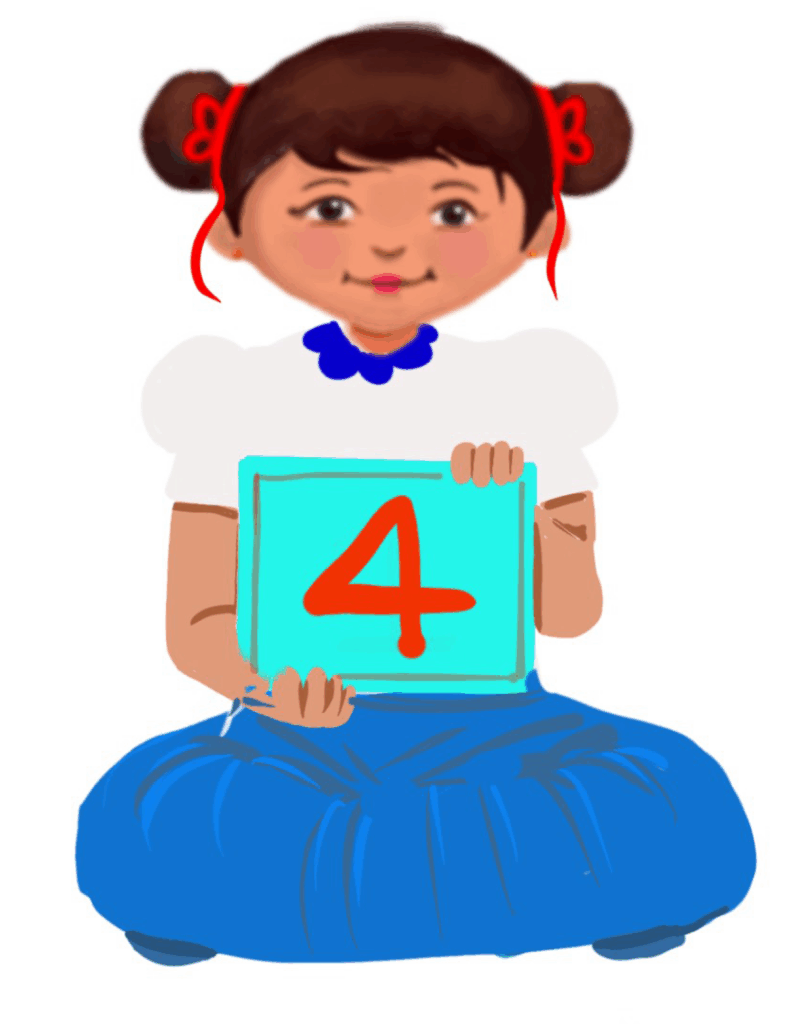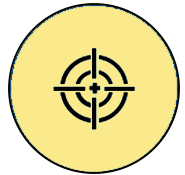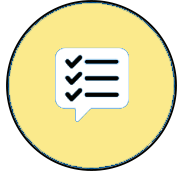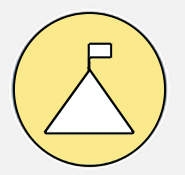
Files and Folders in Windows 10
Class 4
 Objective
Objective
Students will know…
- the concept of files and folders
- how to create, save and open files and folders.
 Prerequisites
Prerequisites
Children should have previous knowledge about…
- hardware and software of the computer
- Windows 10 operating system
- how to use a mouse, trackpad, and keyboard for accessing and interacting with applications.
 Goal
Goal
All
All children will be able to understand the concept of file, folder and subfolders.
Some
Some children will be able to create a folder.
Few
Few children will be able to create a folder and a subfolder on a computer.
Operational Definition
All – This gives the goal, which is the minimum that the teacher must achieve for all students in the classroom.
Some – This gives the goal that the teacher may try to achieve for some students in the classroom who can achieve the suggested goal over and above the goal stated for ‘All’.
Few – This gives the goal that the teacher may try to achieve for a few students in the classroom who can achieve the suggested goal over and above the goal stated for ‘Some and ‘All’.
Materials required:
Technology
- An audio-enabled computer with an internet connection, smartboard projector, and screen.
- All devices like laptops, tablets and desktop computers with accessibility features enabled.
- Screen readers like JAWS and NVDA.
- Large keyboards, built-in screen magnifiers, hearing aids, text-to-speech and speech-to-text software
- Voice recognition software like Siri, Windows Speech Recognition, headsets, etc.
- Writing or typing tools for students.
Teacher Materials
- Whiteboard and markers or blackboard and chalk
- Lesson videos
- Files (Science, Maths, English worksheets) and folders
- Vocabulary cards
- Cones/raised lines/big circular ring/pipe or single-sided adhesive tape/velcro
- Concept cards
- Differentiated Steps to Success Activity Sheet – one per child
Student Handouts
- Handout 1: Worksheets
- Handout 2: Differentiated Steps to Success Activity Sheet – one per child
Print Preparation
The teacher will print, copy or laminate (wherever applicable):
- Concept cards
- Vocabulary cards
- Worksheets
- Differentiated Steps to Success Activity Sheet – one per child
Preparation for the Activity:
- All the learning and teaching materials needed for this lesson plan must be ready before the lesson begins.
- Ensure that there are enough copies for all children. Multiple copies can be made by photocopying too.
- Please have the assistive technologies and accessibility features ready for your inclusive classroom.
- The teacher must create a folder for each child within the class folder to save their files.
Setup for transacting the lesson:
This topic must be taught in the classroom or a computer lab.
Notes to the teacher:
- The teacher has to begin the class by introducing the concept card provided.
- The students have to be provided with worksheets.
- The students could also note down the concept words in their notebooks as these are introduced during the lesson. They could also try to write the meaning of the words in their language.
1. Expected Prior Knowledge
Awareness of the extent of student’s prior knowledge of the topic will help the teacher plan and deliver the lesson appropriately.
This could be assessed through the provided worksheet.
Worksheet: Pre-Assessment
Enlarged Worksheet: Pre-Assessment
LTM: Pre-teach Vocabulary
3. See, Remember, Organise!
Preparation for the Activity:
Preparing will help you to conduct a practical activity in an inclusive classroom and achieve the aim.
Setting for the activity:
All are classroom activities, but variations for open space are suggested wherever possible. All children can work individually. However, children who need peer support can work with their peers.
Variation for the activity:
Visually impaired children should be allowed to touch the items on the table.
Children with speech impairment should be allowed to draw or write the name of the item on a piece of paper.
Procedure:
- The teacher can make the children stand in a semicircle around the table.
- The teacher gathers several items such as a pen, pencil, eraser, book, ruler, apple, banana, grapes, potato, onion, tomato, spoon, steel glass, and plate. Place these in a random order and keep them covered on a table before beginning the activity.
- The teacher should uncover the items for one minute and ask the students to observe them carefully. Once the time is up, the teacher should cover the table again and ask the students to recall all the items they had seen. The teacher should then take note of how many items were correctly recalled by the students and record them on the board.
- The teacher has to segregate the items according to their category, e.g. all fruits in one place, and repeat the game.
- The teacher counts how many items were correctly recalled and notes it on the board. This is likely to be higher than the first.
- The teacher then explains that when items are organised, it is more convenient to locate them.
Key skill the child will acquire: Children will develop the ability to organise and arrange things better. This activity will also improve concentration and attention span.
4. A Beautiful Rainbow!
One day, little Miraya saw something beautiful in the sky.
“What is that, Mama?” she exclaimed in wonder. Mama said, “That is a rainbow!”
“It’s so beautiful! Can we click a picture of it?” “Yes!” said mother. But before she could click a picture, the rainbow disappeared.
Miraya was very sad. So, her mother drew a rainbow on a sheet of paper and coloured it for her.
She told Miraya that the colours of the rainbow are always in the order of violet, indigo, blue, green, yellow, orange and red. We call it VIBGYOR!
Miraya was very happy.
The next day, Miraya drew a rainbow and started to colour it. But she forgot the order of the colours. She coloured the rainbow in any colour. Her rainbow was not beautiful. She was very sad.
Then, Mama saw the drawing and told her the correct order of the colours.
Now, Miraya made a beautiful rainbow. Mama said, “It is important to be organised, just like the rainbow!
Children, you must remember – A place for everything, and everything in its proper place! This is the best way to be organised!
(Here, we can explain that we must allocate places for everything/everyone and then make sure that everything/everyone is in the right place.)
Role Play: The children could be asked to wear T-shirts of the seven colours of the rainbow or hold squares or C-shaped cut-outs of the rainbow colours. They could then be asked to stand in groups in the order of VIBGYOR.
Video: A Beautiful Rainbow WIP
Video: A Beautiful Rainbow with ISL WIP
5. Match it to the Right Home!
Preparation for the Activity:
Preparing will help you to conduct a practical activity in an inclusive classroom and achieve the aim.
Materials required for this activity:
Files (assorted Science, Maths, and English worksheets) and three folders.
Setting for the activity:
All are classroom activities, but variations for open space are suggested wherever possible. All children can work individually. However, children who need peer support can work with their peers.
Variation for the activity:
Visually impaired children should work with a peer. The peer should read the file, and the child can then put it in the respective folder.
Procedure:
- The teacher can make the children sit in three semi-circles.
- The teacher provides files (assorted Science, Maths, and English worksheets) and three folders for each group.
- The folders have to be labelled Science, Maths and English.
- The children must segregate the worksheets and put them into their folders.
Key skill the child will acquire: Children will develop the ability to organise and arrange files in the folders better.
Video: Activity Time WIP
6. Where do I belong?
Wordwall: Where do I belong?
7. Files and Folders
File: A file is anything created on a computer, whether a picture or text.
File name: A file name tells us something about the contents of the file without having to open it.
File extension: A file extension is that which appears after the file name to identify the file type.
Examples of file extensions
.png or .jpg – paintings, photographs or any image.
.avi or .mp3 – music
.txt or .doc or .odt – text files
Folder: A folder is where files are stored on a computer.
Folders help us:
a) Organise related documents or files together.
b) Locate important files quickly.
A folder that is present inside another folder is called a subfolder.
The main folder is called the parent folder.
Arranging folders into parent and subfolders is called directory structure.
LTM: Concept Cards
8. Files and Folders: Click and Explore
Files are like pages, neat and small,
Folders are like bags, holding them all.
Files hold pictures, music, and text,
Folders keep them, who’s up next?
Files are saved, one by one,
Folders keep them all in one.
Click on a folder, open it wide,
Files are waiting, neatly inside!
Video: Files and Folders: Click and Explore WIP
Video: Files and Folders: Click and Explore with ISL WIP
Try me
9. Create, name and save a file
Open Notepad/TextPad application. The application opens
Type some text
To save your work, click on File.
Click on Save as
Type a file name in the file name box
Click Save
This creates the Notepad file or the TextPad file
Video: Create, name and save a file
Video: Create, name and save a file with ISL
Worksheet: Activity Sheet
10. Create a New Folder
- Go to the desktop screen
- Right-click and click on New
- Click on folder
- Type a folder name you want for your folder
- Press Enter
The new folder with the file name will be seen on the desktop.
Video: Create a New Folder
Video: Create a New Folder with ISL
Try me
Video: Creating a shortcut
Video: Creating a shortcut with ISL
Video: Renaming a file/folder
Video: Renaming a file/folder with ISL
11. Assessment
Activity 1:
- Open Notepad/Textpad/MS Word.
- Type the text below.
| Little Elephant Raj In colourful India, a little elephant named Raj roamed the land. He danced under the bright sun with his friends, spreading joy and happiness. |
- Save the file named ‘Little Elephant’ on your desktop.
Activity 2:
- Go to the desktop screen
- Right-click and click on New
- Click on the folder
- Type your name
- Press Enter.
The new folder with the file name will be seen on the desktop.
12. Assistive Technologies and Adaptive Devices
Assistive Technologies and Adaptive Devices
Teacher Resource Document
| Source and Attribution of images: All images used in the above Assets and Aids are originally created. https://www.freepik.com/free-vector/garbage-sorting-set_13146308.htm#query=bin&position=16&from_view=search&track=sph&uuid=f3b8502d-37b2-4fcf-9f70-6a0c2975cf15 Image by pch.vector on Freepik |
| This digital material has been developed by the Sri Sathya Sai Vidya Vahini Inclusive Education Project, a unit of Sri Sathya Sai Central Trust, Prasanthi Nilayam, as a collaborative offering in the service of our nation. |